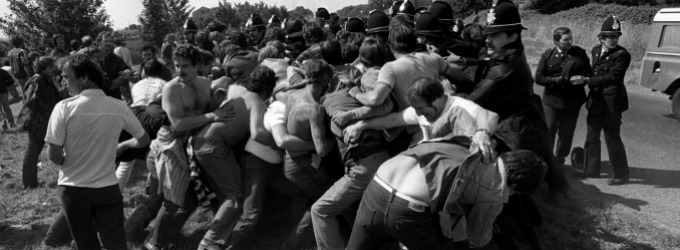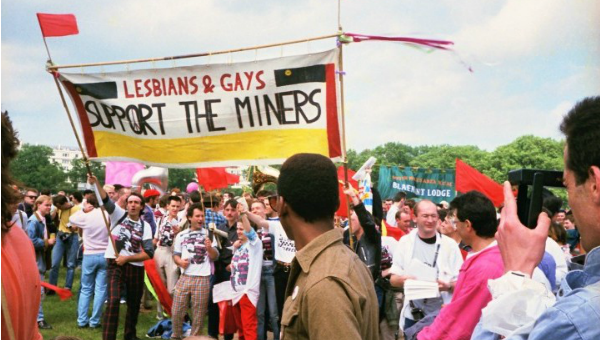 The documentary DANCING IN DULAIS is exactly as it was in 1986. Nothing has been added or subtracted. It has the feel of an artefact dug up and put on display, still slightly covered in soil and bearing the watermarks of its hibernation. At times the background music, over-excited, drowns out the words of someone being interviewed on the screen. At other times the analogue video seems to degrade to the point that faces and marching feet blur into a grainy kaleidoscope of psychedelic shapes. No modern narrator has been added to guide the viewer through the archival images, nor has new editing attempted to splice together the old footage with faces as they are now, remembered accounts or reconstructions. Maybe this is why the documentary feels so vital, dynamic and virile, as opposed to nostalgic and distant.
The documentary DANCING IN DULAIS is exactly as it was in 1986. Nothing has been added or subtracted. It has the feel of an artefact dug up and put on display, still slightly covered in soil and bearing the watermarks of its hibernation. At times the background music, over-excited, drowns out the words of someone being interviewed on the screen. At other times the analogue video seems to degrade to the point that faces and marching feet blur into a grainy kaleidoscope of psychedelic shapes. No modern narrator has been added to guide the viewer through the archival images, nor has new editing attempted to splice together the old footage with faces as they are now, remembered accounts or reconstructions. Maybe this is why the documentary feels so vital, dynamic and virile, as opposed to nostalgic and distant.
This short film foreshadows the release of PRIDE (to be shown at the festival on Friday at 7.15pm), documenting the unexpected relationship between LGBT groups and the miners and their families in Dulais in South Wales. The footage includes shots of miners marching at Gay Pride demonstrations, wildly packed fundraising meetings and the operating of a van bought for the miners by the Lesbians and Gays Support the Miners (LGSM) movement. Whilst the images are raw and unchanged, their modulation to the big screen forces them to act in different ways. The 1.25:1 aspect ratio battles playfully against the cinematic widescreen, whilst the stains and cicatrices left over time in the grain of the footage evolve into new shapes and movements across the image. Some of the interviews seem entirely yellow in hue, whilst others blue, red, green. This is a living document which refuses to be archived away, incubating within its evolving grain the colourful militancy and haphazard generosity of its origin.
“every woman is a lesbian at heart!”
This eclectic clash of colour, undulating sounds and music becomes a fertile canvas for a radically different kind of politics. As both individuals and crowds flash past the screen, the absence of names, titles and explanations beneath the interviewees establishes a queer politics fuelled by the collective, the dissonant and the plural. Power here refuses to settle at a singular, discrete site, instead circulating fluidly and unpredictably through channels of desire and enjoyment. Contained within these flashing images is a sense of the humour and pleasure of the coalition; one memorable shot shows LGSM members enjoying a round of bingo whilst another records one of the many chants, “every woman is a lesbian at heart!”
This humour and energy carries wonderfully the movement’s main ethos: not only should politics not have to exist apart from desire, plurality and enjoyment; politics quite literally cannot exist without these elements. The documentary’s delight in these central energies, however, impresses upon the modern audience the frantic need for their revival. At just twenty minutes, many spectators stayed behind in the cinema after its finish, wondering whether anything was coming next. Slightly dazed, people turned to each other, laughed, wondered what exactly they had just seen. This is a documentary that refuses to adhere to any rigid agenda in its enjoyment. The delirious kinesis of DANCING IN DULAIS proves infectious. Let’s just hope it spreads.
Dancing in Dulais screens on 4 and 5 September at 12pm at the Cambridge Film Festival.
httpvh://youtu.be/lHJhbwEcgrA

